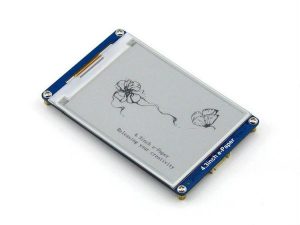Screen technologies have evolved over the years since the cathode ray tube was first demonstrated in 1897, we have moved from plasma to LCDs, followed by LEDs, OLEDs, and more recently e-paper which is what we will look into today. Electronic paper/e-paper displays are display devices which were created to mimic the appearance of ink on a common paper. Unlike the other kind of displays which emit light, e-paper displays reflect light just like an ordinary paper. This gives e-paper displays a wider viewing angle, ensure they consume less power and makes looking at them easier as it gives the same feel as looking at an ordinary paper without the glare that comes from looking at a screen. The coolest feature of this display is its ability to display the last text or graphics uploaded to it even when it is not connected to power. This helps save a lot of power and is the key feature for most applications for which e-paper displays are deployed.
The popularity of e-paper displays is on the rise (used in Amazon’s Kindle) due to the unique features mentioned above, that’s why, for this tutorial, we will look at how to use e-paper displays in Arduino projects, to give the projects an extra layer of sophistication and coolness.
E-paper displays come in different sizes like every other kind of display, but for this tutorial, we will use the Waveshare 4.3″ e-paper display. Some of the features of this display are listed below.
- Easy to use, display any content via one serial interface, including geometric graphics, texts, and images
- Embedded font libraries, supports 32, 48 and 64 dot matrix GBK Chinese fonts and English fonts
- Built-in 128MB NandFlash, allows the font/image data to be stored in either an external TF card or the internal NandFlash
- 4 grey level displaying, 800×600 resolution
- Adjustable serial interface baud rate, 115200 by default when power up
- Powered from 3.3V to 5V, compatible with 3.3v/5v logic level.
- Ultra low power consumption, sleeping current lower than 5mA
Our basic goal with this project will be to display basic text and graphics on the e-paper display, by doing this, we will be able to cover the functions that may be needed for you to use the e-paper display in your own custom projects.
Required Components
The following components are required to build this project;
- Arduino Uno
- E-Paper display
- Jumper wires
- Breadboard
As usual, the exact version of the components used for this tutorial can be bought via the links attached to each of them. The link attached to the e-paper display above takes you to the page where you can acquire the 4.3″ e-paper display but any other display size can be used for this tutorial.
Schematics
E-paper display generally uses UART protocol for communication with microcontrollers. The display has five pins including;
- VCC
- GND
- Din (data in pin)
- Do (data out pin)
- Wake up pin
Connect the display to the Arduino as shown in the schematics below. Depending on the accessories that come with your own display, you may need to use a breadboard or not.
Read more: Using Waveshare 4.3″ E-paper Display with Arduino

